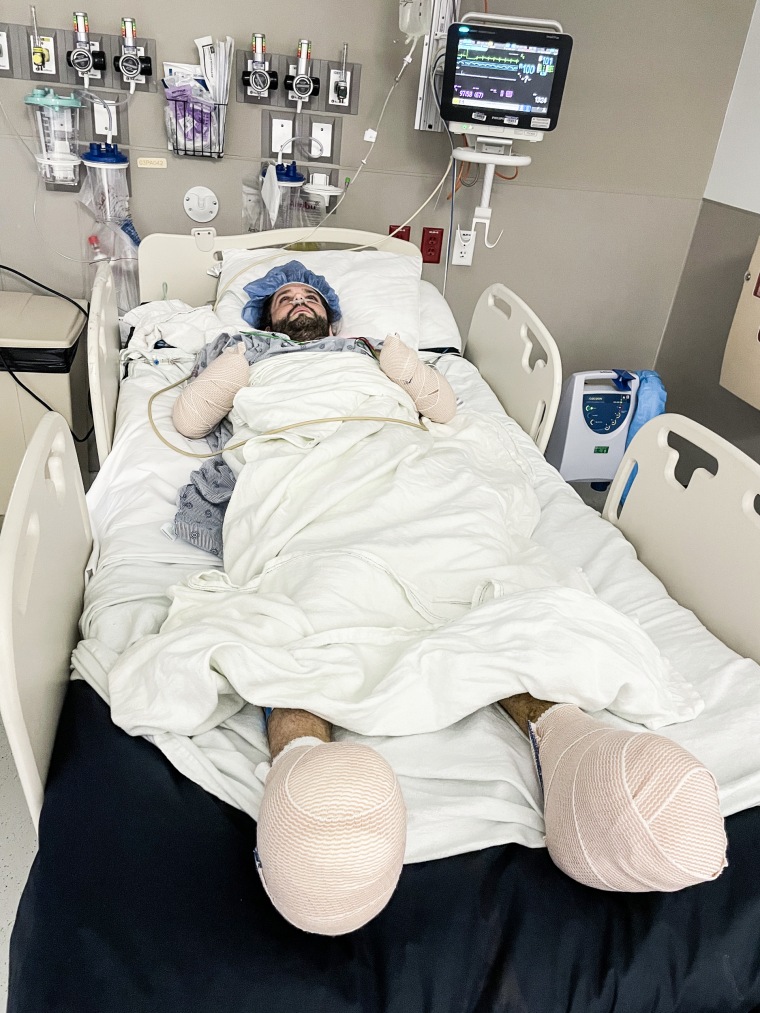A Texas man has lost his hands and parts of his feet after contracting a severe case of typhus from a flea bite.
Michael Kohlhof, 35, began to show flu-like symptoms, including a fever and upset stomach, last month, according to his brother, Greg Kohlhof. A week after the symptoms set in, Michael’s condition worsened rapidly.
Once he couldn’t get out of bed in late June, Greg said, Michael went to the emergency department at a hospital in San Antonio. He went into septic shock soon after and was transferred to the intensive care unit.
In the weeks since, Michael’s toes, an inch of his feet and his hands up to his forearms have been amputated because of dry gangrene — a consequence of sepsis that blocks blood flow to certain extremities.
Michael, who works as a handyman and pet-sitter, regained consciousness earlier this month after being sedated for nearly two weeks, his brother said. Since then, he has been in and out of procedures to patch up his amputations with skin grafts, though doctors are still monitoring to make sure dead tissue from the gangrene doesn’t spread, Greg added.
“He’s on the edge of not being able to keep his feet if things don’t go well,” Greg said. “If they have to cut more feet off, they might have to just do a whole foot amputation for prosthetic purposes.”

Typhus is an infectious disease caused by bacteria that can spread from flea, lice and chiggers. Symptoms typically include fever, chills and body aches. Flea-borne typhus in particular usually causes nausea, cough, stomach pain and a rash from the bite that arises around day five of the illness, according to the Centers for Disease Control and Prevention.
Fleas and lice transmit the bacteria that causes typhus when the bugs defecate upon biting and the excrement infects the wound.
Though typhus is rare in the United States, it has been found in Southern California, Hawaii and Texas, according to the CDC. The agency does not report annual typhus data, but in 2022 California saw 164 probable cases of flea-borne typhus, mostly concentrated in Los Angeles County. Texas reported 591 cases in 2019, the most recent data available there.
True case totals may be higher than reported because most are relatively mild, so many people don’t seek tests or diagnoses, according to Dr. Jason Bowling, an infectious disease specialist at UTHealth San Antonio, who was not involved with Michael’s case. Since typhus symptoms are similar to many viral infections and some people don’t develop a rash, he said, it can be difficult to determine which cases will become severe.
However, Bowling added, “if you were exposed to stray animals or flea bites and then weeks later, you’re starting to have fever and chills, that might be something you seek health care for — and make sure to mention that you’ve had contact.”
Michael Kohlhof’s sister-in-law, Maria Virginia Kolhof, said that when his early symptoms set in, “he really thought he had a flu or something like that, so he was very stubborn to go initially” to the hospital.
Greg said the family is unsure when and where his brother was exposed. The incubation period for flea-borne typhus ranges from seven to 14 days.
After Michael was hospitalized, Greg said, it took almost a week to diagnose his typhus.
“They ended up throwing the kitchen sink at him — gave him all sorts of antibiotics, steroids, everything we could until they got the proper diagnosis,” Greg said.
Since typhus is rare, tests often have to get sent to a specialty lab, so results can take several days to come back, Bowling said.
The Kohlhof family created a GoFundMe to support Michael’s treatment, since he doesn’t have health insurance. Greg said his brother has been staying optimistic.
“His spirits are something to be admired,” he said. “He seems to try to keep a positive attitude, keeping himself distracted — I think he’s grabbed onto the notion that he survived death.”






